Cite this document
(People With Mental Health Issues at Increased Risk of Causing Violent Essay, n.d.)
People With Mental Health Issues at Increased Risk of Causing Violent Essay. https://studentshare.org/psychology/1840737-are-people-with-mental-health-problems-at-increased-risk-of-violent-offending-discuss
People With Mental Health Issues at Increased Risk of Causing Violent Essay. https://studentshare.org/psychology/1840737-are-people-with-mental-health-problems-at-increased-risk-of-violent-offending-discuss
(People With Mental Health Issues at Increased Risk of Causing Violent Essay)
People With Mental Health Issues at Increased Risk of Causing Violent Essay. https://studentshare.org/psychology/1840737-are-people-with-mental-health-problems-at-increased-risk-of-violent-offending-discuss.
People With Mental Health Issues at Increased Risk of Causing Violent Essay. https://studentshare.org/psychology/1840737-are-people-with-mental-health-problems-at-increased-risk-of-violent-offending-discuss.
“People With Mental Health Issues at Increased Risk of Causing Violent Essay”. https://studentshare.org/psychology/1840737-are-people-with-mental-health-problems-at-increased-risk-of-violent-offending-discuss.


